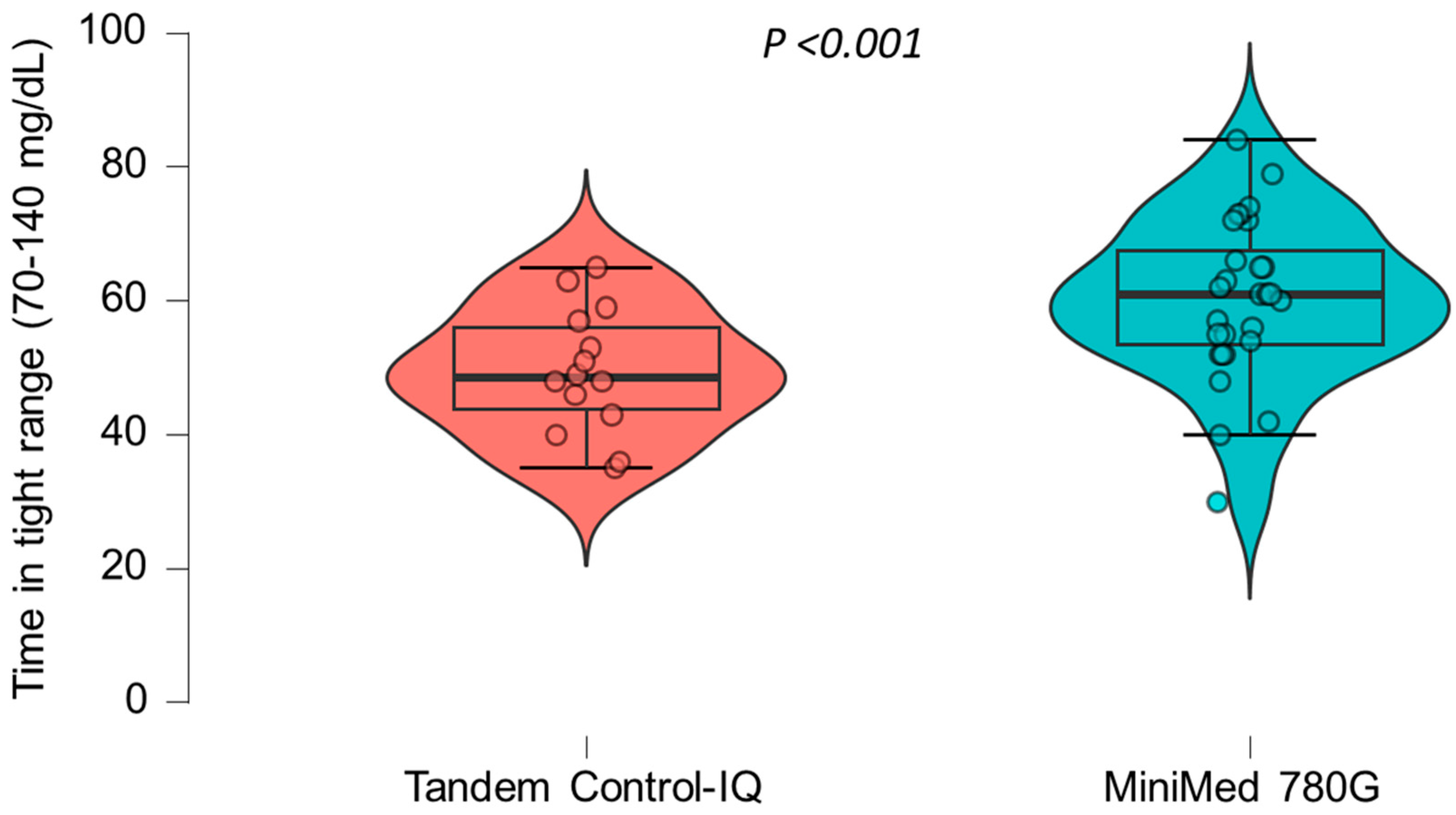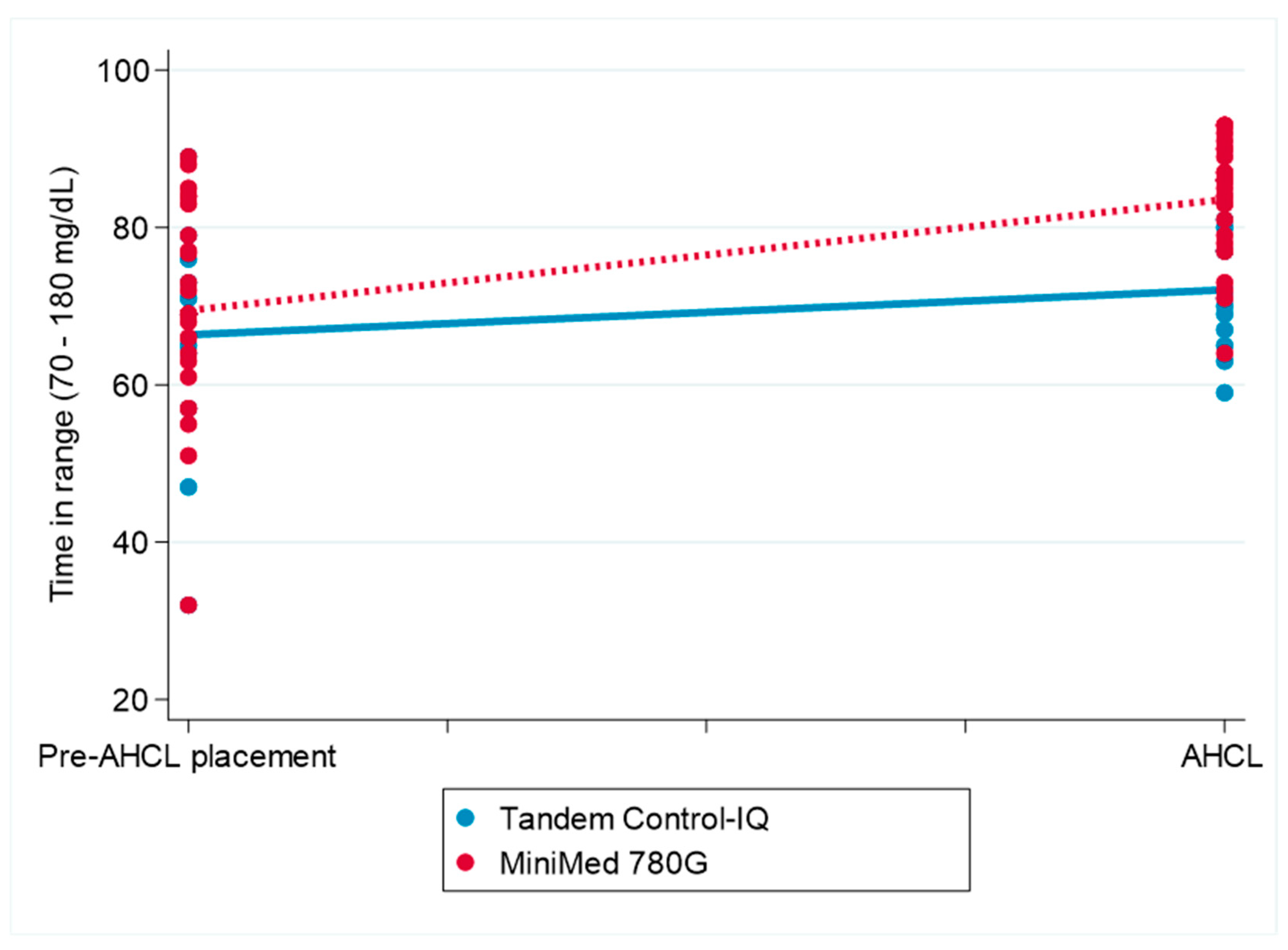Time in Tight Range in AHCL Systems: Propensity-Score-Matched Analysis of MiniMed 780G and Control-IQ
Abstract
1. Introduction
2. Materials and Methods
2.1. Data Collection
2.2. The Statistical Analysis
3. Results
3.1. Baseline Characteristics
3.2. Baseline Differences According to the Pre-AHCL System Use Glucose Metrics
3.3. Post-AHCL System Use Glucometric Outcomes
4. Discussion
Author Contributions
Funding
Institutional Review Board Statement
Informed Consent Statement
Data Availability Statement
Conflicts of Interest
References
- Lu, J.; Wang, C.; Shen, Y.; Chen, L.; Zhang, L.; Cai, J.; Lu, W.; Zhu, W.; Hu, G.; Xia, T.; et al. Time in Range in Relation to All-Cause and Cardiovascular Mortality in Patients With Type 2 Diabetes: A Prospective Cohort Study. Diabetes Care 2021, 44, 549–555. [Google Scholar] [CrossRef]
- Nathan, D.M.; Bayless, M.; Cleary, P.; Genuth, S.; Gubitosi-Klug, R.; Lachin, J.M.; Lorenzi, G.; Zinman, B. Diabetes Control and Complications Trial/Epidemiology of Diabetes Interventions and Complications Study at 30 Years: Advances and Contributions. Diabetes 2013, 62, 3976–3986. [Google Scholar] [CrossRef]
- Moreno, V.N.; Sebastian-Valles, F.; Sampedro-Nuñez, M.; Lahera Vargas, M.; Marazuela, M.; Arranz Martin, J.A.A. Patient satisfaction in three advanced hybrid closed-loop systems at 6 months of treatment in adults with type 1 diabetes mellitus: A follow-up study. Endocrinol. Diabetes Nutr. (Engl. Ed.) 2023, 70, 548–555. [Google Scholar] [CrossRef]
- Henry, Z.; Villar Fimbel, S.; Bendelac, N.; Thivolet, C. Real world evidence of the efficacy of two hybrid closed loop systems for children and adults with type 1 diabetes with some clinical warnings. Diabetes Metab. 2022, 48, 101396. [Google Scholar] [CrossRef]
- Batellino, T.; Alexander, C.M.; Amiel, S.A.; Arreaza Rubin, G.; Beck, R.W.; Bergenstal, R.M. Continuous glucose monitoring and metrics for clinical trials: An international consensus statement. Lancet Diabetes Endocrinol. 2023, 11, 42–57. [Google Scholar] [CrossRef]
- Mayeda, L.; Katz, R.; Ahmad, I.; Bansal, N.; Batacchi, Z.; Hirsch, I.B.; Robinson, N.; Trence, D.L.; Zelnick, L.; de Boer, I.H. Glucose time in range and peripheral neuropathy in type 2 diabetes mellitus and chronic kidney disease. BMJ Open Diabetes Res. Care 2020, 8, e000991. [Google Scholar] [CrossRef]
- Shah, V.N.; DuBose, S.N.; Li, Z.; Beck, R.W.; Peters, A.L.; Weinstock, R.S.; Kruger, D.; Tansey, M.; Sparling, D.; Woerner, S.; et al. Continuous Glucose Monitoring Profiles in Healthy Nondiabetic Participants: A Multicenter Prospective Study. J. Clin. Endocrinol. Metab. 2019, 104, 4356–4364. [Google Scholar] [CrossRef]
- Battelino, T.; Danne, T.; Bergenstal, R.M.; Amiel, S.A.; Beck, R.; Biester, T.; Bosi, E.; Buckingham, B.A.; Cefalu, W.T.; Close, K.L.; et al. Clinical Targets for Continuous Glucose Monitoring Data Interpretation: Recommendations From the International Consensus on Time in Range. Diabetes Care 2019, 42, 1593–1603. [Google Scholar] [CrossRef]
- Meulemeester, J.; Charleer, S. The association of chronic complications with time in tight range and time in range in people with type 1 diabetes: A retrospective cross-sectional real-world study. Diabetologia 2024, 67, 1527–1535. [Google Scholar] [CrossRef]
- Beck, R.W.; Bergenstal, R.M.; Riddlesworth, T.D.; Kollman, C.; Li, Z.; Brown, A.S.; Close, K.L. Validation of Time in Range as an Outcome Measure for Diabetes Clinical Trials. Diabetes Care 2019, 42, 400–405. [Google Scholar] [CrossRef]
- Guo, Q.; Zang, P.; Xu, S.; Song, W.; Zhang, Z.; Liu, C.; Guo, Z.; Chen, J.; Lu, B.; Gu, P.; et al. Time in Range, as a Novel Metric of Glycemic Control, Is Reversely Associated with Presence of Diabetic Cardiovascular Autonomic Neuropathy Independent of HbA1c in Chinese Type 2 Diabetes. J. Diabetes Res. 2020, 2020, 5817074. [Google Scholar] [CrossRef]
- Sundberg, F.; Smart, C.E.; Samuelsson, J.; Åkesson, K.; Krogvold, L. Using Time in Tight Glucose Range as a Health-Promoting Strategy in Preschoolers With Type 1 Diabetes. Diabetes Care 2025, 48, 6–14. [Google Scholar] [CrossRef]
- Burckhardt, M.-A.; Auzanneau, M.; Rosenbauer, J.; Binder, E.; Weiskorn, J.; Hess, M.; Klinkert, C.; Mirza, J.; Zehnder, L.-S.; Wenzel, S.; et al. What is the Relationship Between Time in Range, Time in Tight Range, and HbA1c in Youth and Young Adults With Type 1 Diabetes? Results From the German/Austrian/Luxembourgian/Swiss Diabetes Prospective Follow-Up Registry. J. Diabetes Sci. Technol. 2024, 16, 19322968241288870. [Google Scholar] [CrossRef]
- Folk, S.; Zappe, J.; Wyne, K.; Dungan, K.M. Comparative Effectiveness of Hybrid Closed-Loop Automated Insulin Delivery Systems Among Patients with Type 1 Diabetes. J. Diabetes Sci. Technol. 2024, 1, 19322968241234948. [Google Scholar] [CrossRef]
- Borella, N.D.; Ferramosca, A.; Castagna, G.; Ippolito, S.; Ceresoli, S.; Taverna, A.; Sonzogni, B.; Trevisan, R.; Lepore, G. Comparison of the night-time effectiveness in achieving glycemic targets in adults with type 1 diabetes of three advanced hybryd closed-loop systems. Acta Diabetol. 2025, 62, 763–771. [Google Scholar] [CrossRef]
- Von Elm, E.; Altman, D.G.; Egger, M.; Pocock, S.J.; Gøtzsche, P.C.; Vandenbroucke, J.P. The Strengthening the Reporting of Observational Studies in Epidemiology (STROBE) statement: Guidelines for reporting observational studies. J. Clin. Epidemiol. 2008, 61, 344–349. [Google Scholar] [CrossRef]
- Bassi, M.; Teliti, M.; Lezzi, M.; Iosca, A.; Strati, M.F.; Carmisciano, L.; d’Annunzio, G.; Minuto, N.; Maggi, D. A Comparison of Two Hybrid Closed-Loop Systems in Italian Children and Adults With Type 1 Diabetes. Front. Endocrinol. 2022, 12, 802419. [Google Scholar] [CrossRef]
- Beato-Víbora, P.B.; Chico, A.; Moreno-Fernández, J.; Bellido-Castañeda, V.; Nattero-Chávez, L.; Picón-César, M.J.; Martínez-Brocca, M.A.; Giménez-Álvarez, M.; Aguilera-Hurtado, E.; Climent-Biescas, E.; et al. A Multicenter Prospective Evaluation of the Benefits of Two Advanced Hybrid Closed-Loop Systems in Glucose Control and Patient-Reported Outcomes in a Real-world Setting. Diabetes Care 2024, 47, 216–224. [Google Scholar] [CrossRef]
- Lablanche, S.; Delagenière, S.; Jalbert, M.; Sonnet, E.; Benichou, M.; Arnold, N.; Spiteri, A.; Le Berre, J.-P.; Renard, E.; Chevalier, N.; et al. 12-Month Real-Life Efficacy of the MiniMed 780G Advanced Closed-Loop System in Patients Living with Type 1 Diabetes: A French Observational, Retrospective, Multicentric Study. Diabetes Technol. Ther. 2024, 26, 426–432. [Google Scholar] [CrossRef] [PubMed]
- Beck, R.; Raghinaru, D. A Comparison of Continuous Glucose Monitoring-Measured Time-in-Range 70-180 mg/dL Versus Time-in-Tight-Range 70-140 mg/dL. Diabetes Technol. Ther. 2024, 26, 426–432. [Google Scholar] [CrossRef] [PubMed]
- Passanisi, S.; Piona, C.; Salzano, G.; Marigliano, M.; Bombaci, B. Aiming for the Best Glycemic Control Beyond Time in Range: Time in Tight Range as a New Continuous Glucose Monitoring Metric in Children and Adolescents with Type 1 Diabetes Using Different Treatment Modalities. Diabetes Technol. Ther. 2024, 26, 161–166. [Google Scholar] [CrossRef]
- Dunn, T.C.; Ajjan, R.A.; Bergenstal, R.M.; Xu, Y. Is It Time to Move Beyond TIR to TITR? Real-World Data from Over 20,000 Users of Continuous Glucose Monitoring in Patients with Type 1 and Type 2 Diabetes. Diabetes Technol. Ther. 2024, 26, 203–210. [Google Scholar] [CrossRef]
- Cai, J.; Liu, J.; Lu, J.; Ni, J.; Wang, C.; Chen, L.; Lu, W.; Zhu, W.; Xia, T.; Zhou, J. Impact of time in tight range on all-cause and cardiovascular mortality in type 2 diabetes: A prospective cohort study. Diabetes Obes. Metab. 2025, 27, 2154–2162. [Google Scholar] [CrossRef]
- Wang, Y.; Lu, J.; Bs, J.Y.; Bs, J.N.; Wang, M.; Bsn, W.L.; Bsn, W.Z.; Guo, J.; Zhou, J. Association between time in tight range and incident diabetic retinopathy in adults with type 2 diabetes. Diabetes Obes. Metab. 2025, 27, 1415–1422. [Google Scholar] [CrossRef]


| Variable | Obs N = 42 | Tandem Control-IQ N = 14 | MiniMed 780G N = 28 | p Value |
|---|---|---|---|---|
| Age (years) | 39.2 (±12.8) | 40.3 (±11.8) | 38.7 (±13.4) | 0.6 |
| Sex, woman (%) | 55 | 6 (48.9%) | 17 (60.7%) | 0.3 |
| Insulin/kg (IU/Kg) | 0.6 (±0.2) | 0.6 (±0.2) | 0.6 (±0.2) | 0.4 |
| DM duration (years) | 23.4 (±12.3) | 24.5 (±14.1) | 22.9 (±11.5) | 0.8 |
| BMI (kg/m2) | 25.9 (±4.1) | 25.9 (±3.1) | 25.8 (±4.5) | 0.7 |
| Variable | Obs N = 42 | Tandem Control-IQ N = 14 | MiniMed 780G N = 28 | p Value |
|---|---|---|---|---|
| HbA1C pre (%) | 7 (±0.8) | 6.9 (±0.6) | 7 (±0.9) | 0.8 |
| Average glucose pre (mg/dL) | 140 (±16) | 148 (±13) | 145.3 (±18) | 0.013 |
| CV pre (%) | 34.7 (±7.7) | 33.9 (±3.3) | 36.7 (±9.15) | 0.78 |
| TIR pre (%) | 69 (±18) | 68 (±19) | 69 (±22) | 0.53 |
| TAR pre (%) | 20 (±11) | 21 (±4) | 19 (±14) | 0.71 |
| TAR pre > 250 (%) | 2 (±7) | 6 (±9) | 1 (±5) | 0.04 |
| TBR pre (%) | 5 (±4) | 3.5 (±4) | 6 (±4) | 0.15 |
| TBR < 54 pre (%) | 1 (±2) | 0.5 (±1) | 1 (±2) | 0.44 |
| GMI pre(%) | 6.7 (±0.4) | 6.9 (±0.3) | 6.6 (±0.3) | 0.003 |
| After AHCL system use | ||||
| HbA1C (%) | 6.6 (±0.6) | 6.8(±0.7) | 6.6(±0.5) | 0.478 |
| Average glucose post (mg/dL) | 136 (±15) | 136 (±16) | 136 (±11) | 0.171 |
| CV post (%) | 31.7 (±6.7) | 34.9 (±5.3) | 29.85 (±5.9) | <0.001 |
| TIR post (%) | 78.8 (±9.3) | 72.1 (±7.5) | 83.7 (±7.6) | <0.001 |
| TITR post (%) | 56.6 (±12.2) | 49.5 (±9.3) | 60.1 (±12) | 0.004 |
| TAR post (%) | 17.7 (±6.1) | 16.1 (±7.7) | 12.5(±4.7) | 0.170 |
| TAR > 250 post (%) | 2.6 (±2.7) | 4.1 (±3.7) | 1.9 (±1.8) | 0.136 |
| TBR post (%) | 2.2 (±1.8) | 2.4 (±1.4) | 2.1 (±1.9) | 0.36 |
| TBR < 54 post (%) | 0.5 (±0.7) | 0.6 (±0.6) | 0.36 (±0.7) | 0.53 |
| GMI (%) | 6.6 (±0.3) | 6.9 (±0.4) | 6.5 (±0.2) | 0.082 |
| Variable | Coefficient (β) | Std. Error | 95% CI | p-Value |
|---|---|---|---|---|
| Timepoint | 1.61 | 1.42 | −1.17 to 4.39 | 0.257 |
| Pump type (1 = MiniMed 780G) | –3.94 | 3.97 | −11.73 to 3.85 | 0.322 |
| Timepoint × pump type interaction | 4.81 | 1.74 | 1.40 to 8.22 | 0.006 |
| Sex (female) | 0.26 | 2.02 | −3.70 to 4.21 | 0.898 |
| Intercept | 72.04 | 4.99 | 62.27 to 81.82 | <0.001 |
| Random intercept (ID-level variance) | 14.88 | 7.90 | 5.25 to 42.12 | — |
| Residual variance | 56.39 | 8.70 | 41.67 to 76.31 | — |
Disclaimer/Publisher’s Note: The statements, opinions and data contained in all publications are solely those of the individual author(s) and contributor(s) and not of MDPI and/or the editor(s). MDPI and/or the editor(s) disclaim responsibility for any injury to people or property resulting from any ideas, methods, instructions or products referred to in the content. |
© 2025 by the authors. Licensee MDPI, Basel, Switzerland. This article is an open access article distributed under the terms and conditions of the Creative Commons Attribution (CC BY) license (https://creativecommons.org/licenses/by/4.0/).
Share and Cite
Sanchiz, M.S.T.; Navas-Moreno, V.; Valles, F.S.; López, J.J.R.; La Ganga, C.S.; López, E.C.; Castañar, S.G.; Amar, S.; Vargas, M.L.; Martín, J.A.A.; et al. Time in Tight Range in AHCL Systems: Propensity-Score-Matched Analysis of MiniMed 780G and Control-IQ. Diabetology 2025, 6, 69. https://doi.org/10.3390/diabetology6070069
Sanchiz MST, Navas-Moreno V, Valles FS, López JJR, La Ganga CS, López EC, Castañar SG, Amar S, Vargas ML, Martín JAA, et al. Time in Tight Range in AHCL Systems: Propensity-Score-Matched Analysis of MiniMed 780G and Control-IQ. Diabetology. 2025; 6(7):69. https://doi.org/10.3390/diabetology6070069
Chicago/Turabian StyleSanchiz, María Sara Tapia, Victor Navas-Moreno, Fernando Sebastián Valles, Juan José Raposo López, Carolina Sager La Ganga, Elena Carrillo López, Sara González Castañar, Selma Amar, Marcos Lahera Vargas, Jose Alfonso Arranz Martín, and et al. 2025. "Time in Tight Range in AHCL Systems: Propensity-Score-Matched Analysis of MiniMed 780G and Control-IQ" Diabetology 6, no. 7: 69. https://doi.org/10.3390/diabetology6070069
APA StyleSanchiz, M. S. T., Navas-Moreno, V., Valles, F. S., López, J. J. R., La Ganga, C. S., López, E. C., Castañar, S. G., Amar, S., Vargas, M. L., Martín, J. A. A., & Marazuela, M. (2025). Time in Tight Range in AHCL Systems: Propensity-Score-Matched Analysis of MiniMed 780G and Control-IQ. Diabetology, 6(7), 69. https://doi.org/10.3390/diabetology6070069







